How to drill a well on the water: to help the owner of the
The topic of this article is water well drilling. No, this is not about doing your own work: how to drill wells under water is a topic for a separate article. Our goal is to give the owner of a private house useful advice on the choice of the parameters that professionals usually leave at his discretion.

Well or plumbing
What is better - water supply or well? Is it worth drilling if you are already connected to the city water network?
Refrain from making a decision for the owner of the house.
Instead, we simply dump the arguments in favor of both points of view without any sorting.
- A well is a one-time significant investment; you will have to pay for water all the time. And the further, the more: the price of a cubic meter will inevitably rise.
- If you have your own source of water supply, you will be as independent as possible from the tricks of the public utilities, the rush of the water supply network, scheduled repairs and similar troubles..
- On the other hand, every single problem you have to solve yourself. And some of them can be very serious and require significant investment: for example, deformation of the casing and shedding of the soil in the wellbore or the fall of the pump may require re-drilling, and the path to a smaller compared to the original depth. Any such repair will put the return of the well on a big question.
- Unlike centralized, your water supply will be volatile. Turning off the electricity will leave you without water. The exception is the scheme with a pressure vessel located on the roof of a house or a special tower, which is filled when the pump is turned on and takes a long time.
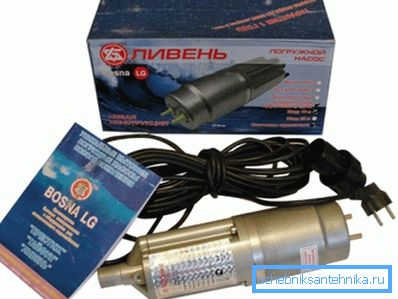
Curiously, the author, having risen before a similar choice in his time, made a simple calculation, according to which a well in his case would pay off in 50 years from the moment of construction. Of course, without taking into account possible repairs. His conclusions are quite predictable.
Season
What time of year to choose?
In most cases, water wells are drilled in the summer.
The reasons are obvious:
- Thawed soil is much easier to drill.
- Snow does not fall asleep wellhead in bad weather.
- In addition, the well is often drilled in parallel with the construction of the house. Which, of course, it is preferable to start in the warm season, when the concrete or mortar freezes in a reasonable time.
Meanwhile, the drillers themselves often recommend choosing, on the contrary, the cold season.
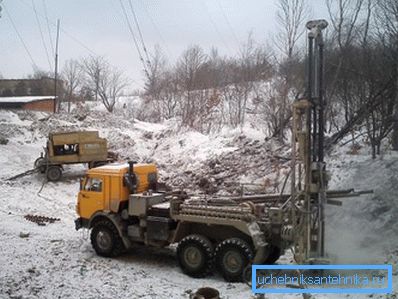
And, you know, their argument is no less convincing:
- The thickness of the frozen layer of soil compared to the total depth of the well is a few percent and does not seriously affect the complexity of the work.
To clarify: the exception, of course, are permafrost regions. With its thickness of tens and hundreds of meters, drilling is equally useless at any time of the year.
- Having frozen, the ground at the site will survive the work of heavy machinery with immeasurably less damage. Even if a garden was chosen as a place for a well.
- The probability of shedding the upper, friable layer of soil is minimal - precisely because it has frozen.
- Finally, the main thing: in winter, the aquifers are the most stable. Their level and saturation are not affected by ice melting and precipitation.
Another strong argument in favor of winter drilling is purely organizational: because of the lower load of the drillers, you will have to wait for your turn much less than during the warm season.
A place
How to find out where to drill a well under water?
Let's divide the problem into two parts.
- We need to find out whether there is potable water in our area.
- When available, it is desirable to determine where it is most advantageous to locate the well relative to the house and other objects.

Geological exploration
There are a couple of indirect signs that water is present in the ground, and at a relatively shallow depth.
- Lush vegetation with lots of shrubs and low trees. The presence of willow, lingonberry, bird cherry, wild rosemary, clover, heather gives close water.
- The abundance of small insects, climbing the ground.
However, besides drilling on sand (that is, to the upper aquifer), drilling on limestone is practiced to a depth of 50-70 meters. In this case, the external signs of near water can not be detected.
How to find out whether to think about drilling?
- The very presence of limestone - sedimentary rock - indicates the probable presence of aquifers.
- In addition, no one has canceled a survey of neighbors and contact with relevant organizations. If in one of the neighboring courtyards there is a well in the water - you are unlikely to waste your money on drilling.
- Finally, another method of geological exploration requires the presence of special high-tech equipment, but it still costs much cheaper than trial drilling. This - VES, vertical electrical sounding, which allows to determine the composition of the soil on its electrical resistance.

Location on the site
How to determine - where to drill a well under water, if its presence on your site is confirmed?
We will immediately stipulate that when using the VES method, it is desirable to start with the drilling of a well, and then build a house and other structures in association with it. The fact is that VES allows determining the location of aquifers with extremely high accuracy; It is quite possible that the distance to the water on one edge of the site will be 20-30 meters less than on the other.
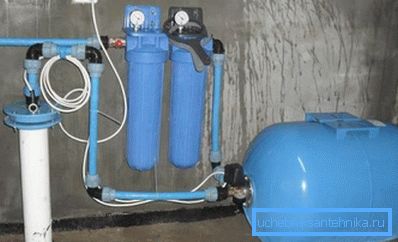
If the site is already planned and built up - these are the principles that should be followed.
- Choose a place with a slight incline. On slopes of 35 degrees and more drilling is simply impossible.
- Minimum distance from the house - 3 meters. The instruction is related to the possible shrinkage of the foundation during drilling. However, you shouldn’t get too far from the walls either: the water is brought into the house below the level of soil freezing, and to dig a trench tens of meters long is a dubious enterprise.
- The minimum distance from potential sources of pollution (landfills, cesspools, etc.) is 50 meters. Filtration of polluted water along the wellbore is unlikely, but possible.
Depth
Often, at a point selected for drilling, there are several aquifers at different depths. What is more preferable - drilling on sand (up to 35 meters) or on limestone (50 meters or more)?
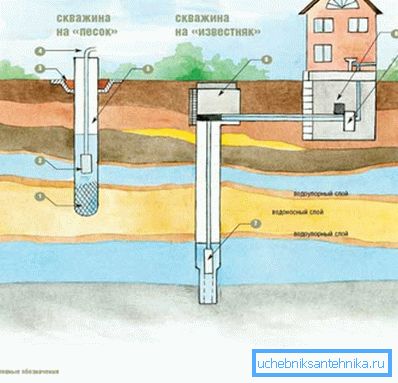
The meter, passed the drill, will cost you about 2000 rubles. If the difference in cost is not decisive - the second option is definitely preferable.
Why?
- The probability of getting contaminated water is immeasurably less.
- The care required by the well is minimal. In the first case, it will constantly silt and need frequent pumping, in the second case, pumping will be required at least in ten years time.
- The probability of ground movement with damage to the casing and shedding of the trunk is less than an order of magnitude.
Casing
Where and how to drill a well under water - we seem to have figured it out. However, it is also important to strengthen its walls by providing some protection to the pump and the water pipe leading from it. What is better to use as a casing?
We touched on a very painful topic. Opinions of drillers on this subject vary greatly, and each advocates his point of view.
Let's exclude all subjective evaluations and give only those characteristics of materials that are difficult to challenge.
- Black steel pipes are a classic solution, which completely solves the problem of displacement of soil layers due to its strength. With a wall thickness of 6 mm, the service life of pipes, despite the inevitable corrosion, is estimated to be at least 50 years.
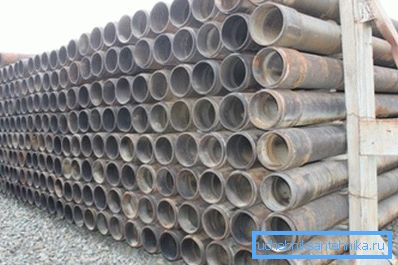
- Galvanized steel does not corrode; however, zinc oxide, which inevitably appears in oxygen-saturated water, is toxic and tends to accumulate in the body.
- Enameled steel is afraid of chipping, which are inevitable when installing the casing. Each chip is the future place of through pipe damage by corrosion.
- Asbestos cement pipes are quite fragile; they are difficult to lower into the well without damage. But in the event that it was possible, the service life of the casing is almost unlimited.
In addition: when drilling a well on the sand, a part of the column is a filtering section. It is impossible to make perforation in asbestos-cement and at the same time to preserve the strength of the pipe at an acceptable level.

- Polyethylene is cheap, durable, but easily crushed when the ground moves and has a tendency to float along the trunk due to the low density of plastic.
- PVC is denser and tougher, which makes it occupy an intermediate position between steel and polyethylene. However, of course, he does not reach the strength of steel pipes.
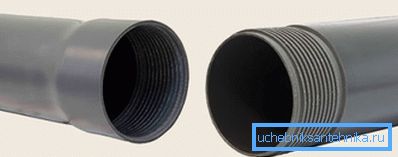
Conclusion
We hope that the proposed material will be useful to the reader. Of course, some questions were left out of our attention; You may find the answers to them by viewing the video in this article. Successes!